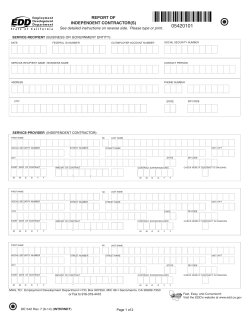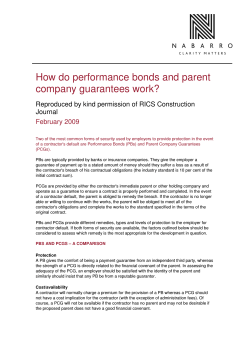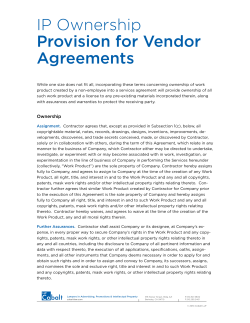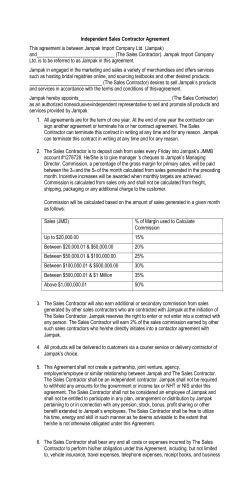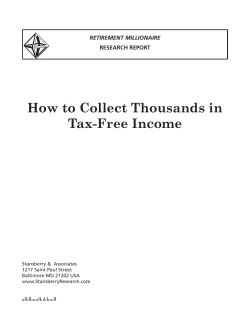
How to manage the top 5 property risks Stephen Morris, Partner, Acuity
How to manage the top 5 property risks 12th June 2014 Stephen Morris, Partner, Acuity Graham Waller, Account Executive, Willis The shield of insurance • Parties covered – owner, landlord, tenant, lender(s), other interested parties, successors in title • Period of title insurance policy usually perpetuity. Other insurances are either annual or limited term • 60% of paid claim usually legal costs/ investigation fees • Requires no material previous approach to affected party Benefits to insured of taking out a policy Transfers financial risk Peace of mind Quicker than legal negotiations Competitive premiums Managing the top 5 property risks A right of light claim during development Title and search risks and liability arising as part of due diligence Designation of land as common land/village green Contaminated Land Ineffective procurement in construction of development Right of light claims When and how do they arise? What effect do they have on development – the risk of injunction? o o o o Shelfer v City of London Electric Lighting Co (1895) Regan v Paul Properties DPF No 1 Ltd (2007) HKRUK II (CHC) Limited v Heaney (2010) Coventry v Lawrence (2014) Right of light claims continued/… How can a developer remove or reduce its risk? o Negotiate settlement o Issue light obstruction notice o Section 237 Town and Country Planning Act 1990; or o Insurance Availability of insurance and nature of cover Requirements of insurer and disclosure of policy Title and search risks Developer’s options o o o o Withdraw from the transaction Ignore defects/covenant Engage lawyers and advisors to resolve the defect/covenant Transfer the risk to an insurer Absence of Easements Inferior Title Rent Charges Lack of Access Defective Leases Reservation of Rights Adverse Possession Lack of Planning Chancel Repair Forfeiture of Lease Lost Deeds Mines and Minerals Restrictive Covenants Rights of Light Judicial Review Designation as common land/village green Effect of designation as common land or town or village green Registration as tactic to thwart development o Section 15 of Common Act 2006 o Lewis v Redcar (2010) Redressing the balance - Growth and Infrastructure Act 2013 (England only) o Reduction of grace period o Landowner statements o Trigger events Draft Wales Planning Act Contaminated Land Clean up liability – purchasers, developers, tenants “Further action” desktop survey Steps to assess/manage liability o o o o Commission full environmental survey Apportion liability Indemnities Insurance policy Construction Risks 12th June 2014 James Williams, Partner, Acuity Mike Carolan, Construction Practice, Willis Design and Build Procurement Employer Main Contractor Subcontractors Consultants (only to prepare the “Employers Requirements”) Consultants: Architect Engineer Other Consultants Two Stage Procurement • Two separate stages distinct from normal procurement • Early contractor involvement - Input into design - Costs - Buildability - Programme • Early order of materials Two Stage Procurement Stage 1 Stage 2 Pre-construction Phase Construction Phase Pre-construction activities on the basis of an agreed pre-construction timetable and for an agreed pre-construction price Initial Engagement of the Contractor and the Design Team Site investigation and preparation works Design development by the consultants with input from the contractor Layered build-up of prices with subcontractor involvement Agree terms of the building contract, consultancy agreements, Employer’s Requirements, the Contractor’s Proposals and other documents Achieve final price within the client’s project budget. If not, re-tender on the open market. Sign the building contract , Novate Consultants, commence the works How can this reduce risks? • The Contractor is better prepared • The price is more certain • The timeframe is more certain • Risks have been identified and dealt with prior to commencement. Owner Coordinated Insurance • In the last 20 years nearly all major construction projects have been protected by project specific insurance programmes • Financiers have fuelled this trend by taking a greater interest in the cost & scope of insurance in order to protect their investments • The benefits of an OCIP also apply to small and medium sized projects • By arranging an OCIP the contractual risks remain with the contractors but some insurance responsibility may change • Important that OCIP considered at early stage prior to going out to tender for maximum benefit Owner Coordinated Insurance – Why? Address key material damage, liability and financial risks Provides control, certainty, flexibility and ultimately peace of mind to parties Ease of transfer to operational insurance programme Competitive premium rates Meet Financiers requirements BUT….. • Insurance costs directly borne by developer – will the contractor discount his insurance price to account for this? Owner Coordinated Insurance – Scope • Contract works • Existing structures • Additional costs of working • Increased costs of constructing incomplete & unbuilt works • Public Liability • Non negligence - JCT 2011 Clause 6.5.1 • Advanced loss of income/delay in start up Owner Coordinated Insurance Advanced Loss of Income Very important element of an OCIP Provides cover for Advance Loss of Rent, Profit, Interest etc arising out of damage to the Works (under the policy) which causes delay to Practical Completion Such cover only provided in conjunction with same insurers covering the contract works Does NOT replace contractors LAD’s The Employer will not receive LAD’s for delay, where an extension in time is given following loss by Specified Peril Owner Coordinated Insurance Insolvency of Contractors First priority is to get project back on track If OCIP in place Cover Continues Keep insurers advised Re-tender project If insurances via the insolvent contractors x Contractor insurances cease x Immediate replacement insurances required x Additional increased insurance costs Tenant Fit Out – The Issues • Landlord refusal to waive subrogation against tenant contractors – Why? • Mismatch in Public Liability requirements • Landlord requirements vs contractor purchase – the solutions? • Contract insurance clauses – comply or amend? But when…. Case Study – Fit Out A tenant in a £100M office building in Bishopsgate, London appointed a contractor to undertake £1M fit of out of floor 12. In the tender process JCT Clause 6.7C was used The tenant asked the Building Owner the week before works started for their Contractor to be included in the Buildings insurance policy. The Owner said no. The works started and the JCT contract remained unchanged A fire in the works damaged the Existing Building. The buildings insurers paid the claim and sought recovery from the negligent contractor. The fit out contractor sued the tenant for the losses claimed by the Owner’s insurers, as the tenant had failed to comply with contract. Surety - Bonds 12th June 2014 Sally Webb, Willis What is a Bond? A bond supports a company’s contractual obligations providing financial protection to the project owner or authority against loss from breach of contract or default by the contracting party under the arrangement. i.e. The bond covers the damages suffered by the customer or another interested party in the event of non performance of a contract A contract bond is a tripartite agreement in favour of one………..The Beneficiary! Beneficiary Contracting Party Surety On Demand Bond – What is it and What are the Risks? • An independent banking obligation requiring the Guarantor to pay up to the full amount stated in the bond ‘on demand’ by the Employer • A bond of this type will generally be in short form and expressed to become payable ‘on demand’ • Payment must normally be made notwithstanding protests by the contracting party and without any requirement on the part of the Employer to prove a breach of contract or that any damages have actually been suffered • The contracting party has no defence against a call on such a bond other than proven fraud • Have been used as a ‘lever’ by employers when a contractual dispute has arisen Continued…… • • • • • • An improper call on the bond could jeopardise the solvency of the contracting party Even an Employer owing money to the contracting party can still make a demand for payment It is an obligation wholly independent of the contract If the bond is called neither the contracting party or provider of the bond can give any contractual defence The effects of providing such bonds is to deprive the contracting party of the benefit of all safeguards built into the contract It is not a guarantee, therefore the liability of the bank is not coextensive with the liability of the contracting party under the underlying contract ABI Model Form of Bond The ABI Model Form of Guarantee Bond was published on the 22nd September 1995 with only a few minor cosmetic amendments made since. The wording was published following a lengthy period of consultation with government and local authority advisers, commercial users, construction and engineering bodies and Insurers. There were criticisms of archaic bond wordings made by the House of Lords and this was highlighted in the Trafalgar House v General & Surety (1994) Aims of the ABI Model Form • The aim of the ABI is to produce a model form of bond which: • Is in short form • In clear, modern language • Operates as a guarantee of payment on contractor default and not merely on demand • Provides the employer with an entitlement to damages immediately at the point where the contracting party becomes liable to pay damages under the contract • Minimises the risk of litigation • Contains a clear expiry date • Introduce one industry standard model form of guarantee bond which provides clarity and purpose and equity to the employer, contractor and surety • Cut out the many different bond wordings on use and save all parties time and legal costs associated with the issue of bonds Underwriting Considerations Surety bonds are underwritten as an extension of credit and are written on recourse terms. When underwriting bonds, the Surety considers what is known as the “four C’s”: Capital Credit Capacity Character The Details…….. • • • The bond should contain a limit on the aggregate financial exposure. If an Advanced Payment Bond there should be a reduction in the financial exposure in proportion to the value of goods delivered or services performed For NEC bonded contracts, ensure that either the amended ABI Model wording for use with NEC contracts is used or the following NEC Rider clause is inserted: "PROVIDED FURTHER THAT notwithstanding any provision of the Contract by which, following termination of the Contractor's obligation to provide the Works, the Contractor might be required to make payment in respect of "Damages" on the basis of an estimate, forecast or assessment of the Project Manager or other agent of the Employer under the Contract, the Guarantor shall not be required to make payment under this Guarantee Bond until such time as the Works have been completed and the actual "Damages" have been properly established and ascertained, the liability of the Guarantor under this Guarantee Bond shall be coextensive with the liability of the Contractor under the Contract".
© Copyright 2025




